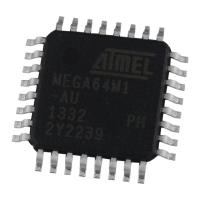42
7647H–AVR–03/12
Atmel ATmega16/32/64/M1/C1
6.5 Standby Mode
When the SM2..0 bits are 110 and an external crystal/resonator clock option is selected, the
SLEEP instruction makes the MCU enter Standby mode. This mode is identical to Power-down
with the exception that the Oscillator is kept running. From Standby mode, the device wakes up
in six clock cycles.
Notes: 1. Only recommended with external crystal or resonator selected as clock source.
2. Only level interrupt.
6.6 Power Reduction Register
The Power Reduction Register, PRR, provides a method to stop the clock to individual peripher-
als to reduce power consumption. The current state of the peripheral is frozen and the I/O
registers can not be read or written. Resources used by the peripheral when stopping the clock
will remain occupied, hence the peripheral should in most cases be disabled before stopping the
clock. Waking up a module, which is done by clearing the bit in PRR, puts the module in the
same state as before shutdown.
A full predictible behaviour of a peripheral is not guaranteed during and after a cycle of stopping
and starting of its clock. So its recommended to stop a peripheral before stopping its clock with
PRR register.
Module shutdown can be used in Idle mode and Active mode to significantly reduce the overall
power consumption. In all other sleep modes, the clock is already stopped.
Table 6-2. Active Clock Domains and Wake-up Sources in the Different Sleep Modes.
Active Clock Domains
Oscillator
s Wake-up Sources
Sleep
Mode
clk
CPU
clk
FLASH
clk
IO
clk
ADC
clk
PLL
Main Clock
Source Enabled
INT3..0
PSC
SPM/EEPROM
Ready
ADC
WDT
OtherI/O
Idle X X X X X X X X X X
ADC
Noise
Reduction
XX X X
(2)
XXXX
Power-do
wn
X
(2)
X
Standby
(1)
XX
(2)
X

